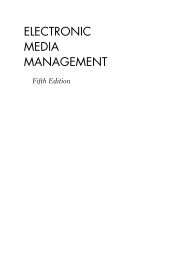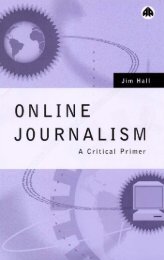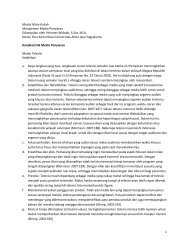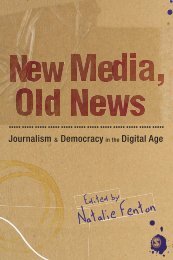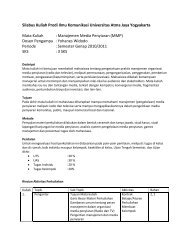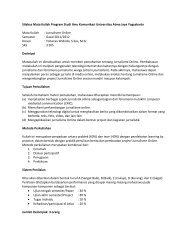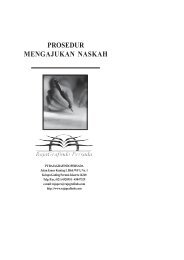Modul Mata Kuliah Journalisme Online - Ayo Menulis FISIP UAJY
Modul Mata Kuliah Journalisme Online - Ayo Menulis FISIP UAJY
Modul Mata Kuliah Journalisme Online - Ayo Menulis FISIP UAJY
Create successful ePaper yourself
Turn your PDF publications into a flip-book with our unique Google optimized e-Paper software.
One unsurfaced assumption in these observations and correlations is that most bloggers will adopt a<br />
coherent political philosophy as informed citizens: a variation on Lockean utilitarianism, Rawlsian<br />
liberalism or Nader consumer activism. To date there is little discussion about how political philosophy<br />
could deepen CJ’s ‘self-image’: how to critically evaluate sources, audit and investigation processes, or<br />
strategies to deal with elites, deterrence and power. For example, although bloggers kept Valerie<br />
Plame’s ‘outing’ as a covert intelligence operative highly visible in the issues-attention cycle, it was<br />
agenda-setting media like The New York Times who the Bush Administration targeted to silence<br />
(Pearlstine). To be viable, CJ needs to evolve beyond a new media populism, perhaps into a<br />
constructivist model of agency, norms and social change (Finnemore).<br />
4. Citizen Journalism as New Media Populism<br />
Several “precursor trends” foreshadowed CJ notably the mid-1990s interest in “cool-hunting” by new<br />
media analysts and subculture marketeers (Gibson; Gladwell). Whilst this audience focus waned with<br />
the 1995-2000 dotcom bubble it resurfaced in CJ and publisher Tim O’Reilly’s Web 2.0 vision. Thus, CJ<br />
might be viewed as new media populism that has flourished with the Web 2.0 boom.<br />
Yet if the boom becomes a macroeconomic bubble (Gross; Spar) then CJ could be written off as a “silver<br />
bullet” that ultimately failed to deliver on its promises (Brooks, Jr.). The reputations of uncritical<br />
proponents who adopted a “true believer” stance would also be damaged (Hoffer).<br />
This risk is evident if CJ is compared with a parallel trend that shares its audience focus and populist<br />
view: day traders and technical analysts who speculate on financial markets. This parallel trend provides<br />
an alternative discipline in which the populism surfaced in an earlier form (Carlile & Christensen 12).<br />
Fidelity’s Peter Lynch argues that stock pickers can use their Main Street knowledge to beat Wall Street<br />
by exploiting information asymmetries (Lynch & Rothchild). Yet Lynch’s examples came from the mid-<br />
1970s to early 1980s when indexed mutual fund strategies worked, before deregulation and<br />
macroeconomic volatility. A change in the Web 2.0 boom might similarly trigger a reconsideration of<br />
Citizen Journalism.<br />
Hedge fund maven Victor Niederhoffer contends that investors who rely on technical analysis are<br />
practicing a Comtean religion (Niederhoffer & Kenner 72-74) instead of Efficient Market Hypothesis<br />
traders who use statistical arbitrage to deal with ‘random walks’ or Behavioural Finance experts who<br />
build on Amos Tversky and Daniel Kahneman’s Prospect Theory (Kahneman & Tversky).<br />
Niederhoffer’s deeper point is that technical analysts’ belief that the “trend is your friend” is no match<br />
for the other schools, despite a mini-publishing industry and computer trading systems. There are also<br />
ontological and epistemological differences between the schools. Similarly, CJ proponents who adopt a<br />
‘Professional Amateur’ or ‘Pro-Am’ stance (Leadbeater & Miller) may face a similar gulf when making<br />
comparisons with professional journalists and the production environments in media organisations.<br />
CJ also thrives as new media populism because of institutional vested interests. When media<br />
conglomerates cut back on cadetships and internships CJ might fill the market demand as one<br />
alternative. New media programs at New York University and others can use CJ to differentiate<br />
themselves from “hyperlocal” competitors (Christensen; Slywotzky; Christensen, Curtis & Horn). This<br />
transforms CJ from new media populism to new media institution.



